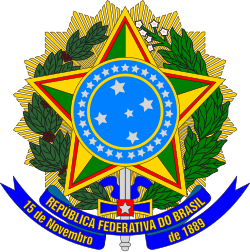Coat of arms of Brazil
The coat of arms of Brazil was adopted on November 19, 1889, four days after Brazil became a republic.
The coat of arms has the central emblem bordered by coffee (at the left) and tobacco (at the right) branches, which are important crops in Brazil.
In the blue circle in the center, the Southern Cross (Portuguese: [Cruzeiro do Sul] Error: {{Lang}}: text has italic markup (help)) can be seen. The ring of 27 stars around it represents Brazil's 26 states and the Federal District.
The blue ribbon has the official name of Brazil (República Federativa do Brasil — Federative Republic of Brazil) in its first line. In the second line, the date of the federative republic's establishment (November 15, 1889) is written.
Coat Of Arms Of Brazil Media
Proposed republican coat of arms, adopted by early republicans after the 1870 Itu Convention, which switched the imperial crown for a Phrygian cap.
Coat of arms of the Colonial Brazil (1500–1815)
Coat of arms of the United Kingdom of Portugal, Brazil and Algarves (1816–1821)
Imperial Coat of arms, design of the first reign (note the crimson velvet within the Crown), kept in usage in the early second reign, until the Coronation of Emperor Pedro II (when the design of the Crown was modified, to reflect the shape of the new Crown, and its dark green velvet cap (1 December 1822 – 18 July 1840)
Coat of arms of the United States of Brazil (1889–1968)
Coat of arms of the Federative Republic of Brazil (1968–1971)








